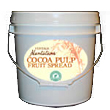
Impact
Appearance 3.7 / 5
primordial
primordial
| Color: | chocolate amber |
| Surface: | spreadable jelly |
| Temper: | shiny bog |
| Snap: | n/a |
Aroma 7.8 / 10
primeval honey... really tests the senses: tapioca molasses + custard-citrus marmalade covered in forest greens (fern, pita palm, balsa, balata [shooting off all sorts of rubber, asphalt, tar, roadside cinders, & diesel fumes] & stinking camacho plant) + chicha = manuka thick enough to include the honeycomb “must” prepared in abbamele
Mouthfeel 12.2 / 15
| Texture: | gel |
| Melt: | pre-melted |
Flavor 41.9 / 50
powers up applesauce along w/ all those honeyed aromatics -> alien flight of tang... wild tangerine... meyer lemon, calamansi, satsuma, yuzu, rosella, loquat & the skin of a granny smith apple -> cooked prune/honey reduction -> flushes out bee spit at the finish
Quality 2 / 20
About as tree-fresh as it gets so automatically this enters the pantheon by virtue of being a 1st in the Northern Hemisphere to to come to market.
Thru this, Plantations takes it way back to cacáo’s roots. Prior to 1847 when the 1st chocolate bar as we know it (admittedly a pretty rough & gritty affair) was created by Fry & Son, Europe followed the lead of the Mayans & Mexìcâs & took it as a beverage. Cacáo originally was cultivated by indigenous people, according to Prof. John Henderson of Cornell University, not for its seeds (aka beans) that today are made into chocolate bar but exclusiviely for the sticky pulp surrounding the seeds inside the pod in order to ferment a liquor or beer called chicha - served during high-social occasions featuring a performance aspect where the drinking pots & vessels in these ceremonies were smashed, Hendrix-style, to heighten the drama of the event.
Nowadays pulp is the ‘seed-secret’ to fermenting seeds in baskets, wooden boxes, or cylinders. A kind of soul-sauce, it kick-starts the integral forces in the cacáo-complex that interlinks with the beans to develop the full flavor profile as its natural sugars placed under anaerobic conditions (the absence of oxygen) promote (i.e., ferment) the activity (i.e., energy) of yeast (single-cell fungi) which turn that sugar into alcohol (think ethanol; beer, wine, etc) & carbon dioxide (same chemical for leavening bread); soon bacteria start to oxidize alcohol into lactic acid then acetic acid (the mainstay of vinegar).
Langston Hughes asked: “What happens to a dream deferred? Does it dry up like a raisin in the sun?” Yes, and that too has value & possibility, encapsulated in the adage ‘the darker the skin, the sweeter the juice’. In cacáo’s case, each of its components still has individual abundance to flourish by itself. Seeds can be processed without undergoing fermentation, rendering a chocolate usually of stronger baseline cocoa flavor, albeit missing notes & accents often found in its fuller spectrum (particulary the high fruits & flowers). And pulp can have an appetizing taste all its own (& if of a sweet scent it serves as a sensory pre-cursor to identifying fine-flavor cacáo in the field). But the benefit of anti-segregation is that once all forces come together, they’re far greater than the sum of their parts.
ING: 90% cacáo pulp, 10% sugar
Thru this, Plantations takes it way back to cacáo’s roots. Prior to 1847 when the 1st chocolate bar as we know it (admittedly a pretty rough & gritty affair) was created by Fry & Son, Europe followed the lead of the Mayans & Mexìcâs & took it as a beverage. Cacáo originally was cultivated by indigenous people, according to Prof. John Henderson of Cornell University, not for its seeds (aka beans) that today are made into chocolate bar but exclusiviely for the sticky pulp surrounding the seeds inside the pod in order to ferment a liquor or beer called chicha - served during high-social occasions featuring a performance aspect where the drinking pots & vessels in these ceremonies were smashed, Hendrix-style, to heighten the drama of the event.
Nowadays pulp is the ‘seed-secret’ to fermenting seeds in baskets, wooden boxes, or cylinders. A kind of soul-sauce, it kick-starts the integral forces in the cacáo-complex that interlinks with the beans to develop the full flavor profile as its natural sugars placed under anaerobic conditions (the absence of oxygen) promote (i.e., ferment) the activity (i.e., energy) of yeast (single-cell fungi) which turn that sugar into alcohol (think ethanol; beer, wine, etc) & carbon dioxide (same chemical for leavening bread); soon bacteria start to oxidize alcohol into lactic acid then acetic acid (the mainstay of vinegar).
Langston Hughes asked: “What happens to a dream deferred? Does it dry up like a raisin in the sun?” Yes, and that too has value & possibility, encapsulated in the adage ‘the darker the skin, the sweeter the juice’. In cacáo’s case, each of its components still has individual abundance to flourish by itself. Seeds can be processed without undergoing fermentation, rendering a chocolate usually of stronger baseline cocoa flavor, albeit missing notes & accents often found in its fuller spectrum (particulary the high fruits & flowers). And pulp can have an appetizing taste all its own (& if of a sweet scent it serves as a sensory pre-cursor to identifying fine-flavor cacáo in the field). But the benefit of anti-segregation is that once all forces come together, they’re far greater than the sum of their parts.
ING: 90% cacáo pulp, 10% sugar




